Global Nanomedicine Market: By Indication, By Molecule Type, By Application, By Region & Segmental Insights Trends and Forecast, 2024 – 2034
- Industry: Healthcare
- Report ID: TNR-110-1159
- Number of Pages: 420
- Table/Charts : Yes
- June, 2024
- Base Year : 2024
- No. of Companies : 10+
- No. of Countries : 29
- Views : 10138
- Covid Impact Covered: Yes
- War Impact Covered: Yes
- Formats : PDF, Excel, PPT
Nanomedicine is a cutting-edge field at the intersection of nanotechnology and medicine, revolutionizing healthcare through the application of nanoscale materials and devices for diagnosis, treatment, and prevention of diseases. By harnessing the unique properties of nanoparticles and nanostructures, typically ranging from 1 to 100 nanometres in size, nanomedicine offers precise and targeted therapies that improve drug delivery, imaging techniques, and diagnostic capabilities. Nanoparticles can be engineered to encapsulate drugs, genes, or imaging agents, allowing for controlled release and specific targeting to diseased tissues while minimizing systemic side effects.
This capability is particularly advantageous in oncology, where nanoparticles can passively accumulate in tumours via the enhanced permeability and retention (EPR) effect, enhancing the efficacy of chemotherapy or delivering therapeutic payloads directly to cancer cells. Moreover, nanomedicine holds promise in personalized medicine by enabling tailored treatments based on individual genetic profiles and disease characteristics, paving the way for more effective and personalized healthcare solutions in the future.
One of the primary demand drivers for nanomedicine is its potential to revolutionize drug delivery systems. Nanoparticles, due to their small size and unique physicochemical properties, offer significant advantages in targeted drug delivery. These nanoparticles can encapsulate drugs, peptides, or nucleic acids, protecting them from degradation and facilitating their controlled release at specific sites within the body. This precise delivery minimizes systemic toxicity and enhances therapeutic efficacy, making nanomedicine particularly attractive for treating complex diseases such as cancer, cardiovascular disorders, and neurological conditions.
Additionally, the increasing prevalence of chronic diseases worldwide, coupled with the growing need for personalized medicine approaches, further fuels the demand for nanomedicine. Advancements in nanotechnology, including the development of multifunctional nanoparticles capable of simultaneous drug delivery and diagnostic imaging, continue to drive innovation in this field. Moreover, supportive regulatory environments and strategic investments in research and development contribute to expanding the market for nanomedicine globally, fostering its integration into mainstream healthcare practices.
In terms of revenue, the global nanomedicine market was worth US$ 17.2 Bn in 2023, anticipated to witness CAGR of 12.4% during 2024 – 2034.
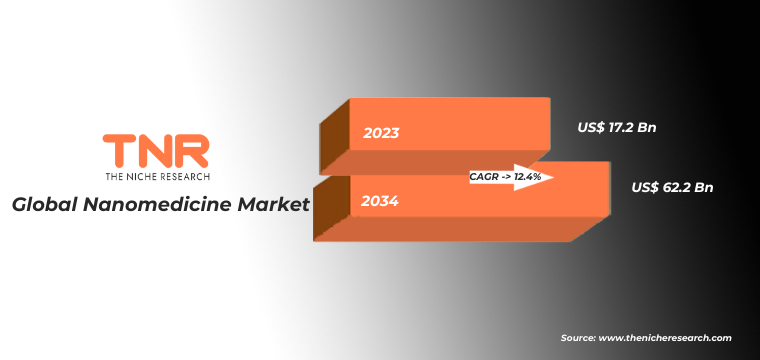
Global Nanomedicine Market Dynamics
Technological Advancements: Continuous innovations in nanotechnology have spurred the development of advanced drug delivery systems, diagnostic tools, and therapeutic agents with enhanced precision and efficacy. These technologies enable targeted treatments for diseases like cancer and neurological disorders, driving market growth by offering improved patient outcomes and reduced side effects.
Rising Chronic Diseases: The increasing prevalence of chronic diseases such as cancer, cardiovascular ailments, and diabetes worldwide necessitates more effective treatment options. Nanomedicine addresses this demand through tailored therapies that target specific disease mechanisms, leveraging nanoparticles and nanostructures to deliver drugs precisely to affected tissues while minimizing damage to healthy cells.
Regulatory Support: Supportive regulatory frameworks across regions facilitate the approval and commercialization of nanomedicine products. Regulations ensure product safety, efficacy, and quality, providing a clear pathway for market entry and expansion while bolstering investor confidence in the sector.
Investment in Research: Significant investments in research and development by governments, academic institutions, and pharmaceutical companies drive innovation in nanomedicine. This funding supports the discovery of novel nanotechnologies and their translation into clinical applications, fostering growth and competitiveness in the global market.

Nanoparticles Segment has Garnered Major Market Share in the Global Nanomedicine Market During the Forecast Period (2024 – 2034).
Nanoparticles play a pivotal role as a demand driver in nanomedicine, revolutionizing drug delivery and diagnostics through their unique properties and applications. These minuscule particles, typically ranging from 1 to 100 nanometres in size, offer advantages such as high surface area-to-volume ratio, tunable surface chemistry, and the ability to encapsulate drugs or imaging agents. In drug delivery, nanoparticles enable targeted therapies by delivering medications directly to specific cells or tissues while minimizing systemic side effects.
This precision enhances treatment efficacy for conditions like cancer, where nanoparticles can accumulate in tumours via the enhanced permeability and retention (EPR) effect. Moreover, nanoparticles are crucial in diagnostic imaging modalities, enhancing contrast agents for more accurate detection of diseases such as cardiovascular disorders or neurological conditions. The growing demand for personalized medicine and advancements in nanotechnology further drive the development and adoption of nanoparticle-based solutions in nanomedicine, positioning them as key drivers of innovation in healthcare globally.
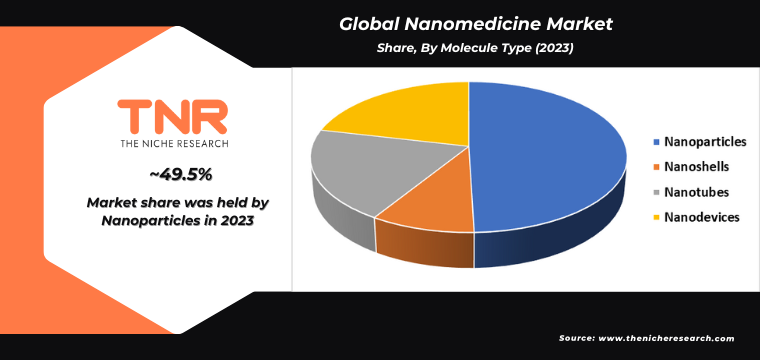
By Application Drug Delivery Segment had the Highest Share in the Global Nanomedicine Market in 2023.
Drug delivery systems within the realm of nanomedicine represent a significant demand driver due to their transformative potential in healthcare. Nanotechnology enables the design and development of precise drug delivery systems that enhance therapeutic efficacy while minimizing side effects. These systems utilize nanoparticles, liposomes, micelles, and other nanostructures to encapsulate and deliver drugs directly to targeted tissues or cells, overcoming biological barriers such as the blood-brain barrier for neurological treatments or tumour cells for cancer therapies. The ability to control drug release kinetics and bioavailability enhances treatment outcomes and patient compliance.
In North America and globally, the increasing incidence of chronic diseases, aging populations, and the demand for personalized medicine further stimulate the adoption of nanomedicine-based drug delivery systems. Moreover, ongoing advancements in nanotechnology, coupled with regulatory support for innovative medical technologies, foster a favourable environment for research, development, and commercialization of novel drug delivery systems, driving the growth of this burgeoning field in healthcare.
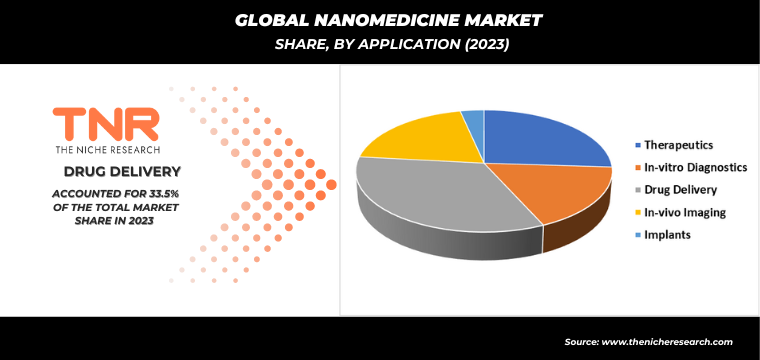
North America, by Region Dominated the Global Nanomedicine Market in 2023.
In North America, nanomedicine is propelled by several compelling demand drivers. Firstly, the region’s robust healthcare infrastructure and substantial investments in research and development foster innovation in nanotechnology applications for medical purposes. Nanomedicine offers precise drug delivery systems, enhanced imaging techniques, and targeted therapies that promise more effective treatments with reduced side effects compared to traditional methods.
The aging population in North America, coupled with the increasing prevalence of chronic diseases such as cancer, cardiovascular ailments, and neurological disorders, underscores the need for advanced medical technologies like nanomedicine. Additionally, regulatory support and funding initiatives from governments and private sectors stimulate growth by facilitating clinical trials and commercialization of nanomedicine products. Moreover, the interdisciplinary nature of nanotechnology encourages collaborations among researchers, clinicians, and industry leaders, accelerating the translation of scientific discoveries into practical healthcare solutions. These factors collectively drive the demand for nanomedicine in North America, positioning it at the forefront of medical innovation and patient care.
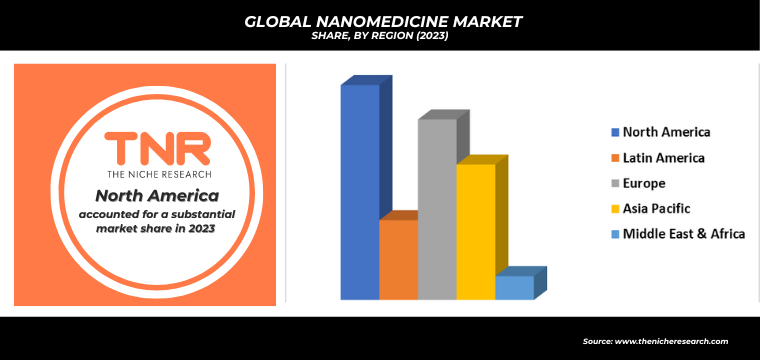
Competitive Landscape: Global Nanomedicine Market:
- Abbott Laboratories
- Arrowhead Pharmaceuticals, Inc.
- Celgene Corporation
- CombiMatrix Corporation
- GE Healthcare
- Johnson & Johnson Services, Inc.
- Mallinckrodt Pharmaceuticals
- Merck & Co., Inc.
- Nanospectra Biosciences, Inc.
- Pfizer, Inc.
- Teva Pharmaceutical Industries Ltd.
- Other Industry Participants
Global Nanomedicine Market Scope
| Report Specifications | Details |
| Market Revenue in 2023 | US$ 17.2 Bn |
| Market Size Forecast by 2034 | US$ 62.2 Bn |
| Growth Rate (CAGR) | 12.4% |
| Historic Data | 2016 – 2022 |
| Base Year for Estimation | 2023 |
| Forecast Period | 2024 – 2034 |
| Report Inclusions | Market Size & Estimates, Market Dynamics, Competitive Scenario, Trends, Growth Factors, Market Determinants, Key Investment Segmentation, Product/Service/Solutions Benchmarking |
| Segments Covered | By Indication, By Molecule Type, By Application, By Region |
| Regions Covered | North America, Europe, Asia Pacific, Middle East & Africa, Latin America |
| Countries Covered | U.S., Canada, Mexico, Rest of North America, France, The UK, Spain, Germany, Italy, Nordic Countries (Denmark, Finland, Iceland, Sweden, Norway), Benelux Union (Belgium, The Netherlands, Luxembourg), Rest of Europe, China, Japan, India, New Zealand, Australia, South Korea, Southeast Asia (Indonesia, Thailand, Malaysia, Singapore, Rest of Southeast Asia), Rest of Asia Pacific, Saudi Arabia, UAE, Egypt, Kuwait, South Africa, Rest of Middle East & Africa, Brazil, Argentina, Rest of Latin America |
| Key Players | Abbott Laboratories, Arrowhead Pharmaceuticals, Inc., Celgene Corporation, CombiMatrix Corporation, GE Healthcare, Johnson & Johnson Services, Inc., Mallinckrodt Pharmaceuticals, Merck & Co., Inc., Nanospectra Biosciences, Inc., Pfizer, Inc., Teva Pharmaceutical Industries Ltd |
| Customization Scope | Customization allows for the inclusion/modification of content pertaining to geographical regions, countries, and specific market segments. |
| Pricing & Procurement Options | Explore purchase options tailored to your specific research requirements |
| Contact Details | Consult With Our Expert
Japan (Toll-Free): +81 663-386-8111 South Korea (Toll-Free): +82-808- 703-126 Saudi Arabia (Toll-Free): +966 800-850-1643 United Kingdom: +44 753-710-5080 United States: +1 302-232-5106 E-mail: askanexpert@thenicheresearch.com
|
Global Nanomedicine Market
By Indication
- Clinical Oncology
- Infectious Diseases
- Clinical Cardiology
- Orthopedics
- Others
By Molecule Type
- Nanoparticles
- Metal & Metal Oxide Nanoparticles
- Liposomes
- Polymers & Polymer Drug Conjugates
- Hydrogel Nanoparticles
- Dendrimers
- Inorganic Nanoparticles
- Nanoshells
- Nanotubes
- Nanodevices
By Application
- Therapeutics
- In-vitro Diagnostics
- Drug Delivery
- In-vivo Imaging
- Implants
By Region
- North America (U.S., Canada, Mexico, Rest of North America)
- Europe (France, The UK, Spain, Germany, Italy, Nordic Countries (Denmark, Finland, Iceland, Sweden, Norway), Benelux Union (Belgium, The Netherlands, Luxembourg), Rest of Europe)
- Asia Pacific (China, Japan, India, New Zealand, Australia, South Korea, Southeast Asia (Indonesia, Thailand, Malaysia, Singapore, Rest of Southeast Asia), Rest of Asia Pacific)
- Middle East & Africa (Saudi Arabia, UAE, Egypt, Kuwait, South Africa, Rest of Middle East & Africa)
- Latin America (Brazil, Argentina, Rest of Latin America)
Report Layout:
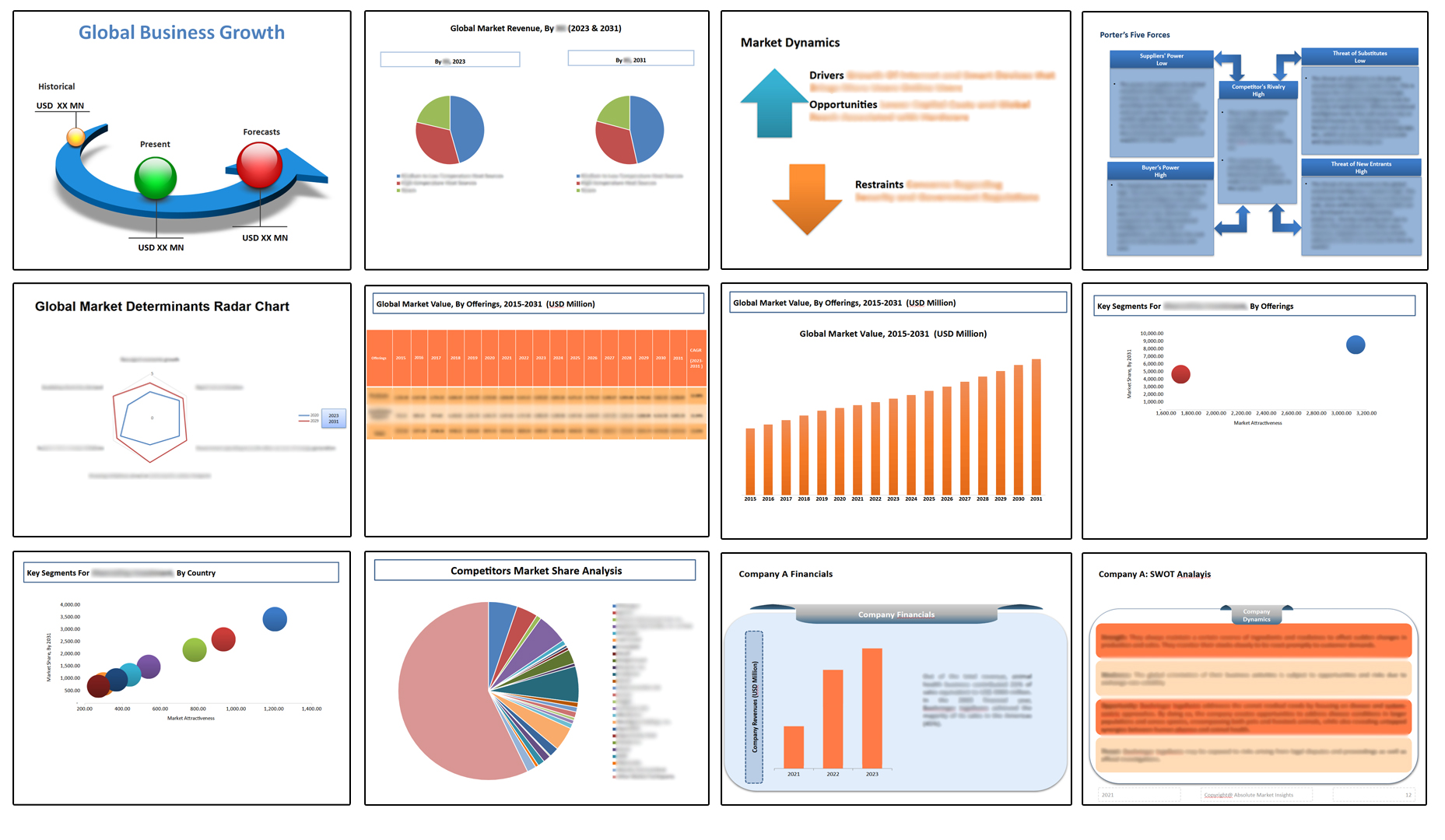
Table of Contents
Note: This ToC is tentative and can be changed according to the research study conducted during the course of report completion.
**Exclusive for Multi-User and Enterprise User.
Global Nanomedicine Market
By Indication
- Clinical Oncology
- Infectious Diseases
- Clinical Cardiology
- Orthopedics
- Others
By Molecule Type
- Nanoparticles
- Metal & Metal Oxide Nanoparticles
- Liposomes
- Polymers & Polymer Drug Conjugates
- Hydrogel Nanoparticles
- Dendrimers
- Inorganic Nanoparticles
- Nanoshells
- Nanotubes
- Nanodevices
By Application
- Therapeutics
- In-vitro Diagnostics
- Drug Delivery
- In-vivo Imaging
- Implants
By Region
- North America (U.S., Canada, Mexico, Rest of North America)
- Europe (France, The UK, Spain, Germany, Italy, Nordic Countries (Denmark, Finland, Iceland, Sweden, Norway), Benelux Union (Belgium, The Netherlands, Luxembourg), Rest of Europe)
- Asia Pacific (China, Japan, India, New Zealand, Australia, South Korea, Southeast Asia (Indonesia, Thailand, Malaysia, Singapore, Rest of Southeast Asia), Rest of Asia Pacific)
- Middle East & Africa (Saudi Arabia, UAE, Egypt, Kuwait, South Africa, Rest of Middle East & Africa)
- Latin America (Brazil, Argentina, Rest of Latin America)
The Niche Research approach encompasses both primary and secondary research methods to provide comprehensive insights. While primary research is the cornerstone of our studies, we also incorporate secondary research sources such as company annual reports, premium industry databases, press releases, industry journals, and white papers.
Within our primary research, we actively engage with various industry stakeholders, conducting paid interviews and surveys. Our meticulous analysis extends to every market participant in major countries, allowing us to thoroughly examine their portfolios, calculate market shares, and segment revenues.
Our data collection primarily focuses on individual countries within our research scope, enabling us to estimate regional market sizes. Typically, we employ a bottom-up approach, meticulously tracking trends in different countries. We analyze growth drivers, constraints, technological innovations, and opportunities for each country, ultimately arriving at regional figures.Our process begins by examining the growth prospects of each country. Building upon these insights, we project growth and trends for the entire region. Finally, we utilize our proprietary model to refine estimations and forecasts.
Our data validation standards are integral to ensuring the reliability and accuracy of our research findings. Here’s a breakdown of our data validation processes and the stakeholders we engage with during our primary research:
- Supply Side Analysis: We initiate a supply side analysis by directly contacting market participants, through telephonic interviews and questionnaires containing both open-ended and close-ended questions. We gather information on their portfolios, segment revenues, developments, and growth strategies.
- Demand Side Analysis: To gain insights into adoption trends and consumer preferences, we reach out to target customers and users (non-vendors). This information forms a vital part of the qualitative analysis section of our reports, covering market dynamics, adoption trends, consumer behavior, spending patterns, and other related aspects.
- Consultant Insights: We tap into the expertise of our partner consultants from around the world to obtain their unique viewpoints and perspectives. Their insights contribute to a well-rounded understanding of the markets under investigation.
- In-House Validation: To ensure data accuracy and reliability, we conduct cross-validation of data points and information through our in-house team of consultants and utilize advanced data modeling tools for thorough verification.
The forecasts we provide are based on a comprehensive assessment of various factors, including:
- Market Trends and Past Performance (Last Five Years): We accurately analyze market trends and performance data from preceding five years to identify historical patterns and understand the market’s evolution.
- Historical Performance and Growth of Market Participants: We assess the historical performance and growth trajectories of key market participants. This analysis provides insights into the competitive landscape and individual company strategies.
- Market Determinants Impact Analysis (Next Eight Years): We conduct a rigorous analysis of the factors that are projected to influence the market over the next eight years. This includes assessing both internal and external determinants that can shape market dynamics.
- Drivers and Challenges for the Forecast Period:Identify the factors expected to drive market growth during the forecast period, as well as the challenges that the industry may face. This analysis aids in deriving an accurate growth rate projection.
- New Acquisitions, Collaborations, or Partnerships: We keep a close watch on any new acquisitions, collaborations, or partnerships within the industry. These developments can have a significant impact on market dynamics and competitiveness.
- Macro and Micro Factors Analysis:A thorough examination of both macro-level factors (e.g., economic trends, regulatory changes) and micro-level factors (e.g., technological advancements, consumer preferences) that may influence the market during the forecast period.
- End-User Sentiment Analysis: To understand the market from the end-user perspective, we conduct sentiment analysis. This involves assessing the sentiment, preferences, and feedback of the end-users, which can provide valuable insights into market trends.
- Perspective of Primary Participants: Insights gathered directly from primary research participants play a crucial role in shaping our forecasts. Their perspectives and experiences provide valuable qualitative data.
- Year-on-Year Growth Trend: We utilize a year-on-year growth trend based on historical market growth and expected future trends. This helps in formulating our growth projections, aligning them with the market’s historical performance.
Research process adopted by TNR involves multiple stages, including data collection, validation, quality checks, and presentation. It’s crucial that the data and information we provide add value to your existing market understanding and expertise. We have also established partnerships with business consulting, research, and survey organizations across regions and globally to collaborate on regional analysis and data validation, ensuring the highest level of accuracy and reliability in our reports.









